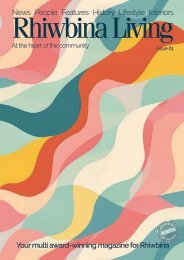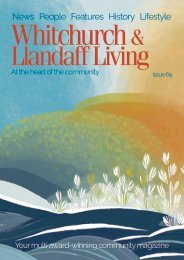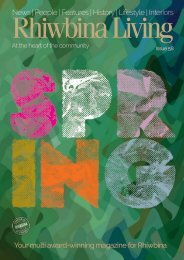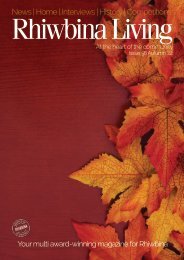Rhiwbina Living
Summer 2023 issue of Rhiwbina Living, the award-winning magazine for Rhiwbina.
Summer 2023 issue of Rhiwbina Living, the award-winning magazine for Rhiwbina.
- TAGS
- wales
- whitchurch
- rhiwbina
- cardiff
Create successful ePaper yourself
Turn your PDF publications into a flip-book with our unique Google optimized e-Paper software.
Rockpooling<br />
Rockpools can last only a few hours but within each one, you can find<br />
a multitude of interesting creatures, all waiting for the tide to return<br />
Beadlet anemone<br />
A common sea anemone found<br />
on rocky shores around all<br />
coasts of the British Isles, the<br />
beadlet anemone displays up to<br />
192 tentacles, all arranged in six<br />
circles. They use these tentacles<br />
to sting and catch passing prey<br />
like crabs, shrimp and small fish.<br />
When the water recedes,<br />
the anemone retracts these<br />
tentacles and the anemone<br />
ends up looking like a red or<br />
orange blob, around two inches<br />
wide.<br />
They can be spotted all year<br />
round in rockpools and along<br />
the rocky shore.<br />
Green shore crab<br />
Commonly found around the<br />
UK, the green shore crab is<br />
usually green in colour but can<br />
sometimes be orange or red-ish<br />
in colour. If you spot one with an<br />
orange blob on its stomach, it'll<br />
be a female carrying its fertilised<br />
eggs for safekeeping.<br />
You can also recognise the<br />
green shore crab by the fact that<br />
it has five upturned spikes on<br />
each side of its upper shell and<br />
three rounded lobes between its<br />
eyes.<br />
Bladderwrack<br />
This type of seaweed is found on the<br />
coasts of the North Sea, the western Baltic<br />
Sea and the Atlantic and Pacific Oceans.<br />
It was the original source of iodine,<br />
discovered in 1811, and was used<br />
extensively to treat swelling of the thyroid<br />
glands related to iodine deficiency. It is<br />
especially common on sheltered shores.<br />
Dog whelk<br />
They may look pretty but dog whelks are<br />
predatory sea snails. Wave action tends to<br />
confine this carnivorous marine gastropod<br />
to more sheltered shores.<br />
To feed, it uses a modified tooth to bore<br />
holes in the shells of prey. An organ on its<br />
foot secretes a shell-softening chemical,<br />
which it releases into the hole, paralysing<br />
the shell's contents, which it then sucks<br />
out.<br />
Common periwinkle<br />
This small, edible sea snail looks<br />
similar to its land-based cousin<br />
but primarily feeds on algae on<br />
rocky ledges.<br />
Also known as winkles, they<br />
have been an important food<br />
source for humans with evidence<br />
of this happening in Scotland<br />
dating back to 7,500 BC.<br />
They are commonly harvested<br />
in baskets at low tide, and its<br />
meat is high in protein, omega-3<br />
fatty acids and low in fat. They<br />
are considered a delicacy in<br />
African and Asian cuisines.<br />
12

















